A C C I M T
Arthur C Clarke Institute for Modern Technologies
Arthur C Clarke Institute for Modern Technologies
RAAVANA-1, Sri Lanka’s first nano-satellite — and the first-ever satellite of any kind built by Sri Lankans — was developed by a team of Sri Lankan engineers through an international technology-collaboration project. The project was carried out by the ACCIMT and Kyutech, positioning it within the Kyutech’s BIRDS-3 CubeSat Programme, with significant support from the United Nations Office for Outer Space Affairs (UNOOSA) and Japanese Aerospace Exploration Agency (JAXA).
It was carried to the International Space Station (ISS) on 17 April 2019 aboard the Cygnus capsule launched on the Antares rocket by NASA. On 17 June 2019, it was deployed into orbit via JAXA’s KiboCube facility on the ISS. RAAVANA-1, with five research missions onboard, operated successfully in orbit for 27 months.
Importantly, the project was realized at a fraction of the typical cost, through the innovative approach adopted by the Director-General & CEO, ACCIMT, Eng. (Dr.) Sanath Panawennage, by way of identifying and optimally mobilizing collaborative opportunities with multiple international partners, thereby overcoming domestic resource limitations.
The name RAAVANA-1, given to the satellite by Dr. Panawennage, was chosen to resonate with the legendary King Ravana of Sri Lankan folklore—renowned for his superhuman powers and said to have built an air vehicle for travel thousands of years ago.
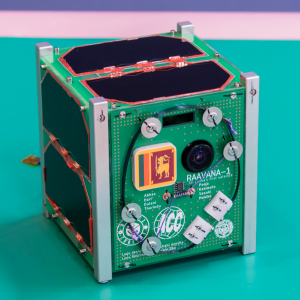

Developed the project concept with an innovative strategy for mobilizing collaboration with multiple international partners, thereby overcoming domestic resource limitations, and managed its implementation. Led the Sri Lankan project team as the Principal Investigator on the Sri Lankan side.
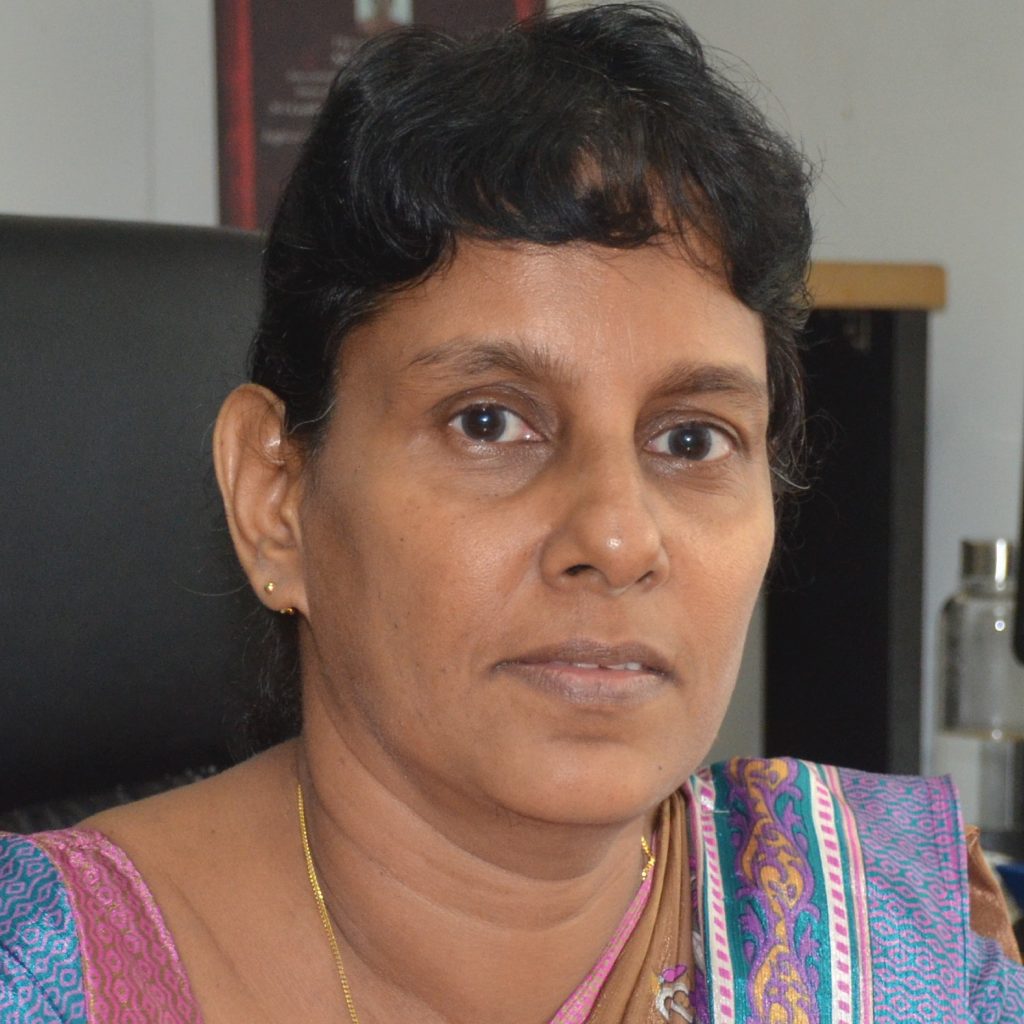
Assisted the Director-General in project planning, monitoring, and management.

Assisted the Director-General in project planning, monitoring, and management. Provided general technical guidance to the research engineers.

Developed and tested all subsystems to required standards, introducing necessary modifications, whilst gaining advanced capacity-building exposure at Kyutech laboratories. Made a decisive contribution to the success of the communication sub-system.

Developed and tested other subsystems to required standards, introducing necessary modifications, whilst gaining advanced capacity-building exposure at Kyutech laboratories.

Designed and developed the ground station facility at ACCIMT for communication with RAAVANA-1.
RAAVANA-1 satellite is a 1U CubeSat standard satellite. The external dimensions of the satellite are 113.5mm x 100mm x 100mm. Figure 1 shows the CAD model of RAAVANA-1 satellite with axis definition. The weight of the satellite is 1.048kg. All the printed circuit boards (PCBs) are connected using 50 pin connectors to a backplane. RAAVANA-1 satellite has four missions in total. They will be described in the below sections.

RAAVANA-1 bus system is using the heritage of BIRDS-1 and BIRDS-2 bus systems. The bus system includes Front Access Board (FAB), Electrical Power System (EPS), On Board Computer (OBC), Communication (COM) and Rear Access Board (RAB). Figure 2 shows the internal bus configuration.
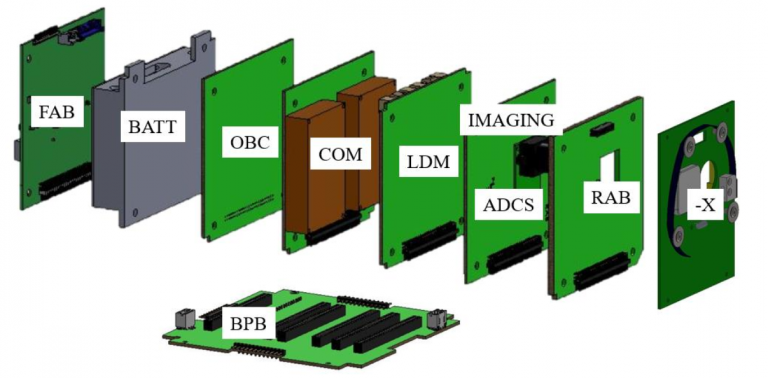
The block diagram of the overall system is shown in figure 4. The microcontrollers used in the bus system are PIC microcontrollers. A PIC16F1789 is used in the FAB board. This PIC collects housekeeping data from solar panels and battery. FAB PIC communicates with Main PIC through UART. The FAB has a kill switch which is controlled by the FAB PIC and Main PIC. Main PIC collects data from FAB PIC every 90 seconds in normal sampling mode. Moreover, Main PIC collects data from FAB every 5 seconds when it comes to high sampling mode.
The OBC includes the Main PIC and a watchdog enabled Reset PIC. The Main PIC which is a PIC18F67J94 and works as the brain of the CubeSat. PIC16F1789 is used as the RESET PIC. RESET PIC keeps the time and resets the Main PIC in case of single event latch up or any other abnormal condition. Main PIC and Reset PIC communicates through UART. Main PIC keeps the housekeeping data, sends the command to deploy the antenna, get uplink commands from COM and execute the missions accordingly. The Main PIC has its own 1GB flash memory which is a MT25QL01GB. Another flash memory is shared between COM PIC and the Main PIC.
Communication subsystem has a PIC16F1789 microcontroller (COM PIC). This PIC is located in OBC board. The responsibilities of COM PIC are to accept the command from the ground station, send those commands to Main PIC, create the CW format and transmit. COM PIC communicates with Main PIC and Reset PIC through UART lines. COM PIC has its own flash memory which is a MTQ25QL01GB 1GB except the shared flash memory. A dipole antenna is located in –X panel. The telemetry data and CW data are sent to ground station by using this antenna. The frequencies used for uplink and downlink are in the amateur radio band. The downlink frequency is 437.375 MHz.
The power is generated by the solar panels attached in five sides of the satellite. Total energy generated by in one orbit is 1490mWh. The satellite has six NiMH batteries and the capacity of one battery is 1900mAh.
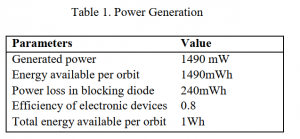
Reset PIC controls the power lines of the satellite. The power lines in the satellite are two 3.3V lines, one 5V line and two unregulated lines. Unregulated line is used for antenna deployment. The antenna is deployed after 30 minutes from ISS deployment. RAB is used to program and to monitor the mission microcontrollers. FAB is used to program and monitor Main PIC, FAB PIC, RESET PIC and COM PIC.
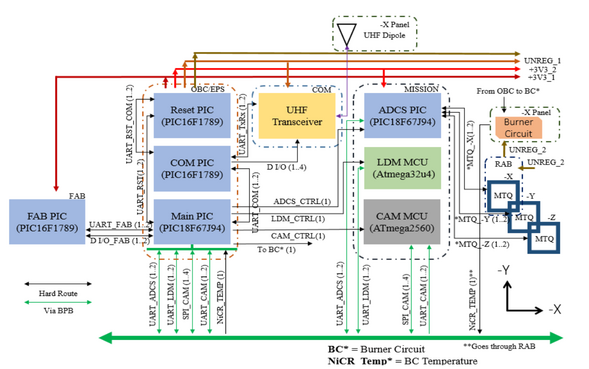
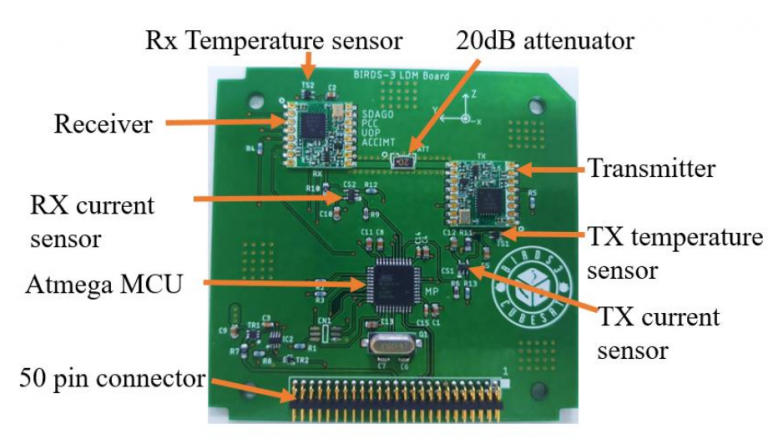
This board has two RFM95W SEMTECH Long Range (LoRa) modulation transceivers, current sensors, Atmega MCU, one 20 dB attenuator and two temperature sensors. One LoRa module operates as a transmitter and the other one operates as a receiver. Atmega32U4 MCU is connected to Main PIC by a UART line. Mission Board-1 is connected to OBC through a 50-pin connector. The main focus of this mission is to verify on orbit operation of LoRa modules by sending data from one module to the other module. LoRa modules are designed to operate in Industrial, Scientific and Medical (ISM) frequency bands which is a non-amateur band. The amateur band and non-amateur band cannot be mixed in the CubeSat according International Amateur Radio Union (IARU). This means uplink by non-amateur band and downlink by amateur band is not allowed. Due to this reason the radio waves are not emitted to outside. First Transmitter LoRa module transmit a packet and then receiver decodes and sends the received data to Atmega32U4 MCU. Atmega324U4 MCU checks whether the received packets has error using cyclic redundancy check (CRC) and monitor the current consumption and the temperature values of the modules.





Since the satellite deployment on June 17, 2019, on-orbit behaviour of LDM was monitored. Transmitter current consumption, receiver current consumption, transmitter temperature, and receiver temperature were observed. There was no abnormal current or temperature observed until the end of the life of the satellite. All the current consumption values were closer to ground testing data. In the ground testing current consumption of the transmitter was 33mA and the current consumption of the receiver was 13mA. Packet success rate was 100 % till end of the life.
RAAVANA-1 was able to take pictures from the space. The followings are some of the pictures taken by the satellite.



